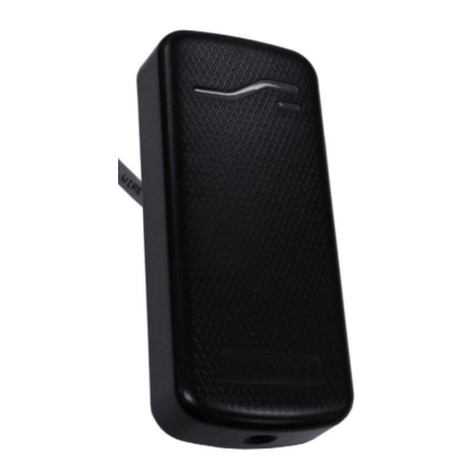
Integriti SIFER Smart Card Reader. Installation Manual. Revision 2.2 August. 2016.
Integriti SIFER Smart Card Reader
P/N: 994720 (Standard)
994720MF (Multi-format)
Overview
The Integriti SIFER Smart Card Reader features a small,
attractive housing suitable for narrow door frames or mullions.
An optical tamper device detects removal from the
mounting surface and triggers the relevant “Reader Fault”
System Input on the host Integriti Module.
The RGB LEDs allow configurable colour, and in an
Integriti system the 2nd LED and the beeper can be used in a
variety of configurations for Valid/Invalid indication, Door/
Area status, DOTL annunciation, Alarm condition, etc.
The standard Reader supports 13.56MHz Inner Range
SIFER Cards utilizing Mifare DESFire EV1 format with AES
encryption. The Multi-format version also reads CSN or UID
data from other 13.56MHz formats including Mifare Classic,
Mini, Ultralight, Plus & JCOP; Felica JIS & NFC; ISO15693;
Type B and Picopass. Refer to the latest SIFER Smart Card
Reader Data Sheet for full details of the formats supported.
Connection to the host Module is via multi-drop RS485
cabling. Up to 16 Readers can be connected on the same
Reader bus. Communication is via industry standard OSDP
allowing compatibility with other Controllers and bus sharing
with other manufacturer’s OSDP devices.
In an Integriti system, SIFER Readers can be automatically
addressed & have firmware updated over the system wiring.
Integriti compatability.
Parts List
- Reader body with integrated pigtail cable.
- Mounting plate.
- Countersunk screw.
- Installation manual. (This document)
Extending Cable
See “Preliminary Installation Notes 3 & 4” on page 2.
The pigtail cable can be extended with twisted-pair multistrand
data cable. Pair 1 for Data A/B; Pair 2 for V+/0V. Shielded
cable provides additional noise immunity. RS485/RS422 data
cable, balanced data cable and multistrand UTP cable are
recommended. Specific recommendations are provided below.
READER POWER: Remember to allow for voltage drop on
V+/0V over longer distances and/or when Readers are wired in
a daisy chain (multi-drop) configuration. Supply voltage drop
on the cable is approx. 17mV per metre per Reader using 7/0.2
(24AWG) cable and assuming each Reader draws 100mA.
OVERALL SHIELD (2 Pair)
Tycab. DPF4702 or DCK4702 Belden. 9842
Electra. EAS7202P or EAS7302P Garland. MCP-2S
General Cable. B2002CS Alpha. 6413
Roadworx. RW600224 Olex. JD2PS485A
OVERALL SHIELD (3 Pair)
Belden. 9843 Tycab. DPF6702
General Cable. B2003CS Garland. MCP-3S
Electra. EAS7203P Electra. EAS7303P
INDIVIDUALLY SHIELDED PAIRS (2 Pair)
Tycab. DQQ47025 Garland. MCP-2IS
Alpha. 2466C Belden. 8723
UTP
Garland UTPL5EMTP (4 Pair stranded UTP patch cable)
If you have a requirement to use other cable types (e.g. short
runs of non-twisted cable), please contact Inner Range
Technical Support for advice.
Specifications
Environment: Operating Temp: -35°C to +65°C.
Ingress Protection: IP67
Physical dimensions. Height: 94 mm Width: 40 mm
Depth: 16 mm
Mounting plate. 91.5 mm (H) x 38 mm (W)
Power supply input: 11-14V DC <500mV ripple.
Current consumption: 75 - 100mA typical. 150mA max.
*Depends on LED configuration.
Maximum Cabling Distance using recommended cables.
Data (Data A/Data B/0V).
Access Module to furthest Reader: 1000m.
Total data cabling on one “RDR RS485” Port: 1000m.
Power (V+/0V). @100mA* per Reader.
To 1 Reader using 2-Pair 7/0.2 cable: 100m.
To 1 Reader using 2-Pair 14/0.2 cable: 200m.
To 2 Readers using 3-Pair (2 pairs for +V/0V) 100m.
For longer cable runs &/or multiple Readers on the same
run, one of the following may be required:
- Heavier duty 2-pair cable.
- Additional pair or separate heavy duty fig. 8 for +V/0V.
- A separate battery-backed local power supply.
See “READER POWER” below for more details.
P 1
tcudorPnoisreVeludoMrepsredaeRREFIS
CAI/CSIretalro0.4V)YLNOCAI(61
MALIretalro0.2V61
MALSretalro0.2V4
erawtfoSitirgetnIretalro0.4Va/n
Due to on-going product development this manual is subject
to change without notice. www.innerrange.com.au
© 2014 - 2016. Inner Range Pty. Ltd. Doc. Part No: 634720




















